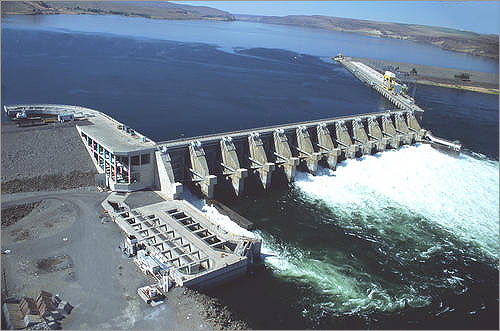Washington State generates about four-fifths of its electricity from renewable resources, including hydroelectric power, and it produces about one-fifth of the electricity generated nationwide from these resources. Some renewable resources provide energy in forms other than electricity, such as the wood used in wood stoves. When these other types of energy are included, renewable resources account for about nine-tenths of Washington’s overall total energy production.

The Columbia River, second only to the Mississippi River in the volume of its flow, provides water for vast hydroelectric projects. The Grand Coulee Dam has a nameplate generating capacity of 6,809 megawatts and is the largest hydropower producer in the United States.
Non-hydroelectric renewable energy sources provide less than one-tenth of Washington’s net electricity generation. However, the state is routinely among the top 10 in electricity generation from these resources. Washington’s wind resource is the largest contributor to non-hydroelectric renewable generation. The state was an early leader in the wind industry and has an installed capacity of over 2,500 megawatts. Washington’s first utility-scale project came online in 2001, and development of resources along the Columbia Gorge, a high wind resource area, has continued in recent years. Washington is also a substantial producer of energy from biomass, primarily wood and wood waste, and the state accounts for about 3% of U.S. net electricity generation from biomass. Mountainous areas over the entire state and a major portion of the lowlands west of the Cascades are covered by timber. Despite the large biomass resource, Washington generates over four times as much electricity from wind as from biomass.
Washington has both high and low temperature geothermal resources. Undeveloped high-temperature geothermal areas in Washington’s volcanic Cascade Range have an estimated electric potential of up to 300 megawatts. If fully developed, it is estimated that this 300-megawatt potential could produce about 2.5 billion kilowatt-hours of electricity per year, enough to provide more than 265,000 average U.S. homes with electricity. Although low-temperature geothermal resources do not have a large impact on the energy economy as a whole, they have direct-use applications, such as heating buildings, greenhouses, and water, and for use in geothermal heat pumps. Over 900 low-temperature geothermal wells have been drilled in the Columbia Basin.
Washington is focused on energy independence, energy conservation, and energy efficiency. With 15 million acres in farms, Washington provides incentives for investment in production and distribution facilities for biofuels created from agricultural and forest product waste. Washington can produce over 100 million gallons of biodiesel per year.
Washington’s Energy Independence Act, enacted in 2006, seeks energy independence in the state, and the Pacific Northwest region as a whole, through increased energy conservation and the use of appropriately sited renewable energy projects. The Act requires large utilities to obtain 15% of their electricity from qualified new renewable resources by 2020 and to undertake cost-effective energy conservation. Washington was the first state in the country to adopt high-performance green buildings standards for state-funded buildings.